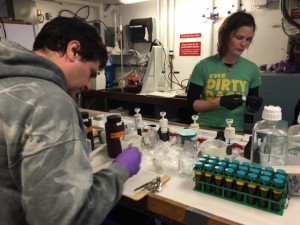12 March 2016
Out on the Ocean
Posted by larryohanlon
by Nanci Bompey
Nanci Bompey is AGU’s public information manager. She is spending a week aboard the R/V Oceanus with scientists from Oregon State University who are studying the role that small rivers play in the productivity of the coastal ocean during the winter. Click here to read Nanci’s previous blogs from this trip.
We finally headed out on the ocean Friday morning. Unfortunately, bad weather is rolling in this weekend so we’re going to head back in Friday night. We’ll hopefully get back out on Monday.
Despite only being a day trip, I still got some flavor for being on a research cruise, including feeling a little queasy around lunchtime. But I spent some time outside and I felt much better. I am, hopefully, getting my sea legs.
Operations on a research cruise assume a rhythm. The ship makes it way to various spots where a number of scientific instruments are deployed. Today, the science crew sampled five locations along the Newport Hydrographic Line, a series of sampling stations that extends hundreds of nautical miles from Newport that oceanographers have been using for decades.
The first instrument deployed is the CTD, one of the most common instruments aboard a research vessel. The CTD measures conductivity. That tells scientists the salinity of the water, which can then be used to figure out how much freshwater is present. The CTD also measures the temperature of the water and the depth, or pressure. Other instruments on the CTD measure fluorescence, which tells scientists about the amount of chlorophyll in the water that is an indicator of photosynthesis, and light transmission, which tells them about the number of particles in the water. The CTD also collects water samples at different depths that are then analyzed in the lab.
It takes three people to get the CTD into the water – one person working the pulley system that lowers the instrument into the water and two people that use ropes to guide the CTD into and out of the water. See the time lapse video here.
Once in the water, the CTD is lowered to just above the bottom of the ocean. Then, water samples are collected at different depths as the CTD is raised to the surface. The CTD also has sonar and an altimeter that scientists use to determine how far the instrument is from the bottom of the ocean.
When the CTD comes back onto the boat, different groups collect water samples that they then analyze in the lab. Miguel Goni’s group runs the water samples through different filters that allow them to analyze the water for larger particles and smaller, dissolved material. The larger particles feed zooplankton, while the dissolved material feeds microbes. The team will also analyze the samples to determine where the material is coming from – the river or the ocean. This information will help the researchers figure out the amount of nutrients being delivered to the ocean by rivers during the winter, an important piece of determining how rivers influence the coastal ocean’s productivity during the winter.
We headed back to Corvallis on Friday night and will hopefully head back to Newport and the Oceanus on Sunday to go back out on the ocean for a few days next week.












 GeoSpace is a blog on Earth and space science, managed by AGU’s Public Information staff. The blog features posts by AGU writers and guest contributors on all sorts of relevant science topics, but with a focus on new research and geo and space sciences-related stories that are currently in the news.
GeoSpace is a blog on Earth and space science, managed by AGU’s Public Information staff. The blog features posts by AGU writers and guest contributors on all sorts of relevant science topics, but with a focus on new research and geo and space sciences-related stories that are currently in the news.